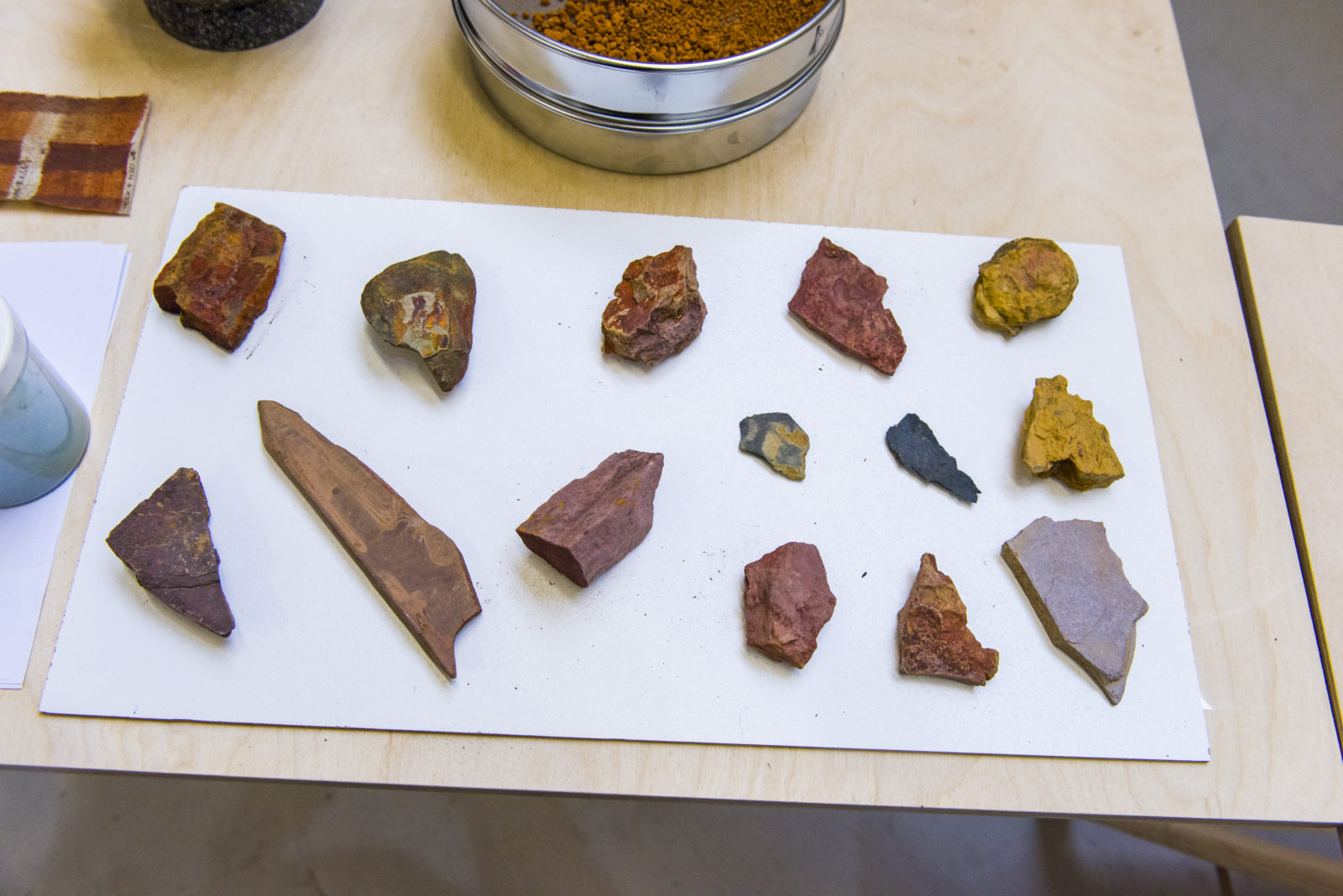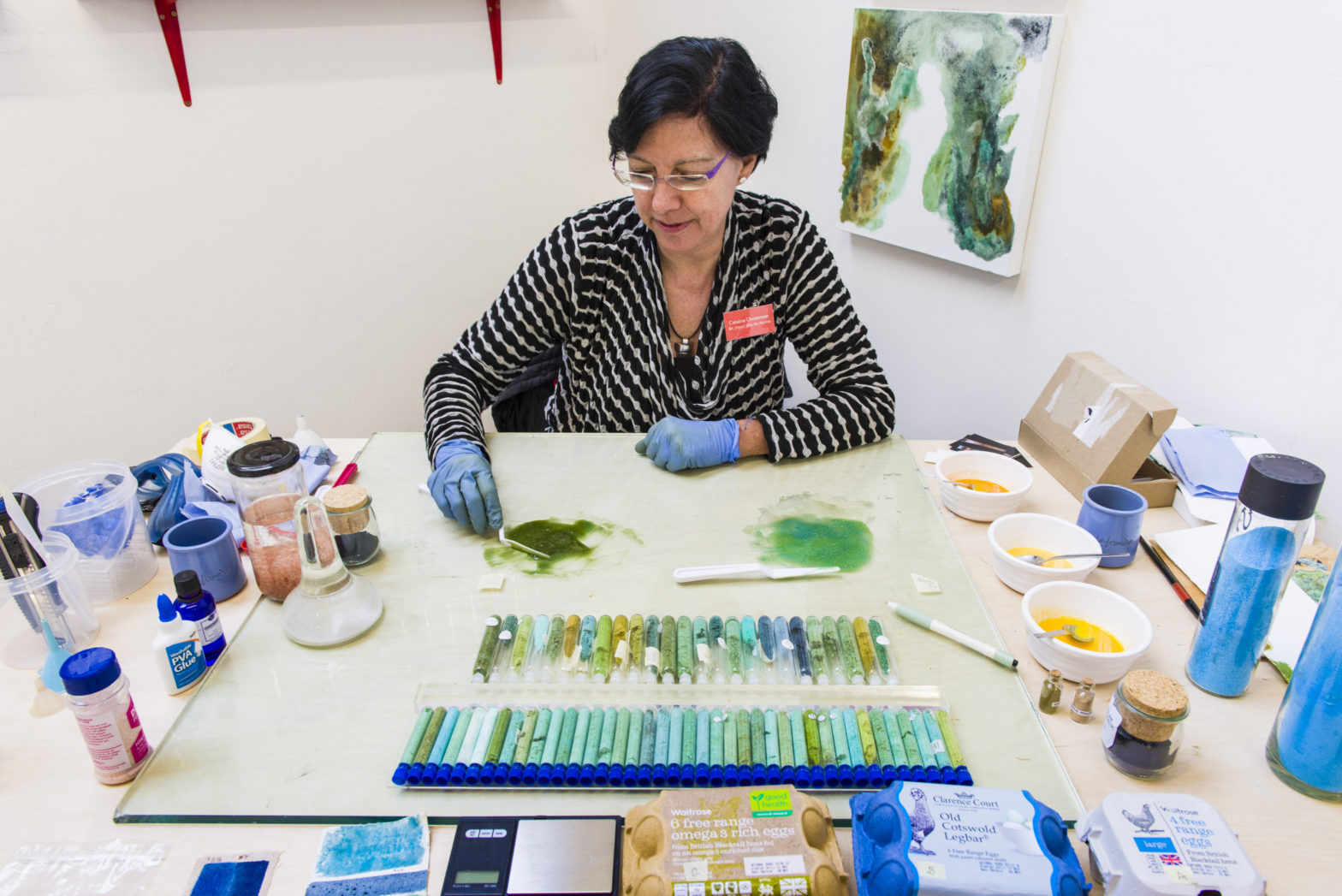Tom Groves, Head of the Art Histories Department at City & Guilds of London Art School, has been in conversation with Catalina Christensen about her fascination with pigment and her environmentally-neutral practice.
TOM GROVES: How did you first become interested in making your own pigments?
CATALINA CHRISTENSEN: From an early age I have been interested in rocks and colour. With my family we used to visit a small town three hours from Bogota that was surrounded by a desert called La Candelaria – a raised sea-bed turned desert – where you could collect fossils and where colourful rocks were scattered all over the ground.
In 2015, when I was a student at CGLAS, I went to Colombia and I visited La Candelaria that I knew from childhood, the fossils are long gone, but the colourful rocks are still there. I came upon some Muisca cave paintings, mostly forgotten, after a nearby mine was forced to cease production and the site was closed to the public. After seeing the beautiful red, black and white pictographs that have been there for over 36.000 years, I had the urge to make pigments from the colourful rocks of the desert. Upon further investigation, it turned out that the red paint was made with cinnabar, ochre and some kind of fat. From then on, in my own work, I decided to use natural materials wherever possible. Currently, I travel to Colombia for a month every year to gather and process rock pigments from the area, unfortunately, in the last couple of years the area has seen a huge increase of weekend homes development threatening the survival of the colourful rocks. I have also started gathering rocks, if possible, from every place I visit.

TOM GROVES: What was it that caught your imagination about the production of your own pigments?
CATALINA CHRISTENSEN: During my artistic career, my fascination with experimentation and the alchemy of materials has led me to use unusual materials like egg shells, coffee, burnt matter, wax, etc. Most importantly, even before I started to paint, I have been attracted to pigments and fascinated by colour. There is something very special about finding a colourful rock and grinding it to reveal the pigment. One of the benefits of making your own pigments is that you decide about their consistency and depth of colour. As a result of my attraction to colour, every time I see an interesting colour, my first thought is whether I can make a pigment of it. Never mind if it is a flower, spice, fruit, earth or rock.
Since 2016, one of my main aims has been to have a practice as environmentally neutral as possible. I have migrated away from oil paints and turpentine, in favour of using egg tempera, due to my personal concerns about the environment and freedom, in particular. Increasingly I became quite concerned with the impact of human activities on the earth and its over-exploitation, (as treated in the theory of the Anthropocene epoch), resulting in widespread and increasing destruction of the environment and pollution. This directly threatens the very places that inspire me. Moreover, mass human migrations and the refugee crisis, which have resulted in the creation of walls and barriers to stop the free movement of people and the containment of them in “provisional” refugee settlements with terrible human and natural costs.
The starting point of my work is the collection and preparation of the pigments, an artistic endeavour in itself. The pigments are as important as the paintings and therefore I include them in my exhibitions along my other works. In fact, I am in the process of creating a comprehensive pigment collection that comprises my own pigments, donations, exchanges with other artists and purchased pigments.

TOM GROVES: What pigments have you made, and how did you learn the processes involved?
CATALINA CHRISTENSEN: The desire to have an environmentally neutral practice using natural materials required me to find a way to source the appropriate natural materials. Life in the studio reveals a complex and unusual practice: the elaboration of pigments leading to the creation of paintings and 3D objects. This singular style is the ever-evolving product of my experimental nature. Even though I have visited a number of important pigment collections and talked with various pigment experts as well as amateurs, as well as read a lot about pigments, the reality is that I enjoy trying different ways of obtaining/creating pigments.
Sometimes I follow traditional recipes, but I always have the urge to experiment and make it my way. I dream about recreating as many historic pigments as possible with or without my own twist.
Currently, I mostly use natural rock pigments which I mainly collect and process in my native Colombia, and homemade charcoal pigments for the earth inspired works from memories of places like La Candelaria and the Atacama desserts. For the more ethereal works inspired by Antarctica, Iceland and the Arctic, it was impossible to collect raw materials in-situ. One either cannot ethically/legally gather rocks in these locations, or the majority are volcanic with a hint of colour in the surface and impossible to grind.
After much experimentation, I have started using indigo dye, metal powders and their compounds reduced and oxidised through the application of chemical processes, which resulted in an amazing array of colours perfect to represent the memories of the above mentioned locations. I am very excited with the prospect of creating as many nuances as possible.
The characteristics of the new beautiful colours were unknown to me. I was concerned that some of the colours may fade with time, but I was uncertain as to how much. With the generous support of Colart, I have been able to test many samples in a Q-Sun Xenon Test Chamber for the fastness of the colours in the next 0 – 50 years and 50 – 100 years.
Fortunately, almost all the colours have performed really well, so I can happily continue to use the metal pigments in my work. As with any pigments, there will inevitably be small changes to the colours over time – in that sense the paintings have their own evolution, which I rather like. The changes will remain minimal, and if the paintings are covered with glass and/or hung indirectly to the sun basically non-existent. On the other hand, I can create ephemeral works with the few pigments that do fade over time.

